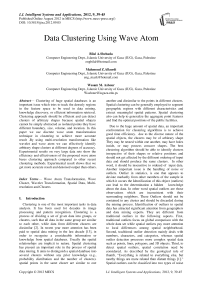Data Clustering Using Wave Atom
Автор: Bilal A.Shehada, Mahmoud Z.Alkurdi, Wesam M. Ashour
Журнал: International Journal of Intelligent Systems and Applications(IJISA) @ijisa
Статья в выпуске: 9 vol.4, 2012 года.
Бесплатный доступ
Clustering of huge spatial databases is an important issue which tries to track the densely regions in the feature space to be used in data mining, knowledge discovery, or efficient information retrieval. Clustering approach should be efficient and can detect clusters of arbitrary shapes because spatial objects cannot be simply abstracted as isolated points they have different boundary, size, volume, and location. In this paper we use discrete wave atom transformation technique in clustering to achieve more accurate result .By using multi-resolution transformation like wavelet and wave atom we can effectively identify arbitrary shape clusters at different degrees of accuracy. Experimental results on very large data sets show the efficiency and effectiveness of the proposed wave atom bases clustering approach compared to other recent clustering methods. Experimental result shows that we get more accurate result and denoised output than others.
Wave Atom Transformation, Wave Cluster, Wavelet Transformation, Spatial Data, Multi-resolution and Clusters
Короткий адрес: https://sciup.org/15010304
IDR: 15010304
Список литературы Data Clustering Using Wave Atom
- Tobler, 1970, W.R.: A computer movie simulating urban growth in the Detroit region. Economic Geography 46 (1970) 234-240
- S. Mallat, 1999, A wavelet Tour of Signal Processing, Second Edition, Academic Press, Orlando-SanDiego.
- J.P. Antoine and R. Murenzi, 1996, Two-dimensional directional wavelets and the scale-angle representation, Sig. Process., vol. 52, pp. 259-281,
- Guojun Gan, Chaoqun Ma and Jianhong Wu, 2007,Clustering Theory, Algorithms, and Application, American Statistical Association and the Society for Industrial and Applied Mathematics.
- Wei Wang, Jiong Yang, and Richard Muntz ,1997, STING : A Statistical Information Grid Approach to Spatial Data Mining, VLDB Conference Athens, Greece.
- ZHAO Yanchang and SONG Jude, 2001, GDILC: A Grid-based Density-Isoline Clustering Algorithm, IEEE 0-7803-7010-4/01.
- Min Deng,Qiliang Liu,Tao and Cheng,Yan Shi, 2011, An adaptive spatial clustering algorithm based on delaunay triangulation., Computers, Environment and Urban Systems .
- Gholamhosein Sheikholeslami, Surojit Chatterjee and Aidong Zhang,1998, WaveCluster: A Multi-Resolution Clustering Approach, VLDB Conference New York, USA.
- Guangzhao Cui, Xianghong Cao, Yanfeng Wang, Lingzhi Cao, Buyi Huang and Cunxiang Yang, 2006, Wavelet Packet Decomposition-Based Fuzzy Clustering Algorithm for Gene Expression Data, IEEE 1-4244-0387-1/06.
- Demanety and L. Ying, 2007. Wave atoms and sparsely of oscillatory patterns, appear in Appl. Comput. Harm. Anal, VoL 23, Issue 3, pp. 368-387
- F. Friedrich H. Fhr, L. Demaret, May 2006 , Beyond wavelets: New image representationparadigms: Survey article idocument and image compression, M. Bami and F. Bartolini (eds), pp. 179-206,.
- E. Candes, D. Donoho, 1999, Ridgelets: A key 10 higher-dimensional intermittency, Philosophical transactions Royal Society, Mathematical, physical and engineering sciences, voL 357, no. 1760, pp.2495- 2509.
- Li Zeng and Lida Xu, 2009, Moving Multi-Object Tracking Algorithm Based on Wavelet Clustering and Frame Difference, IEEE International Conference on Systems, Man, and Cybernetics San Antonio, TX, USA.
- Mohammed A. H. Lubbad and Wesam M. Ashour,2012, Cosine-Based Clustering Algorithm Approach, MECS (http://www.mecs-press.org/) DOI:10.5815/ijisa.2012.01.07.
- Tian Zhang, Raghu Ramakrishnan, and Miron Livny. 1996 BIRCH: An Efficient Data Clustering Method for Very Large Databases. In Proceedings of the 1996 A CM SIGMOD International Conference on Management of Data, pages 103-114, Montreal, Canada.


